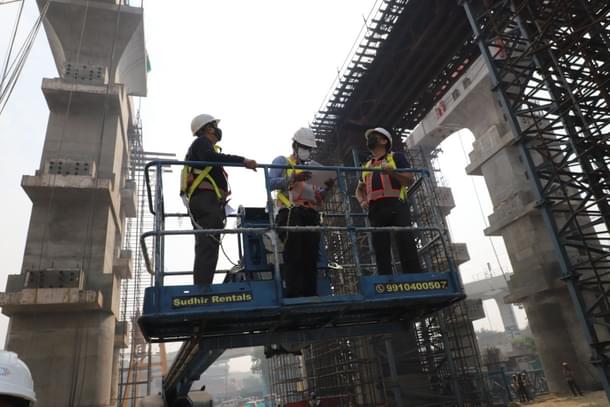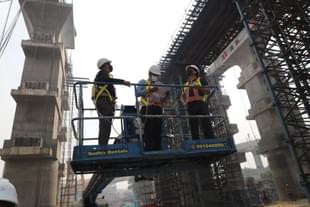News Brief
Delhi-Meerut Regional Rapid Transit System: India's First RRTS Corridor Is Taking Shape At A Rapid Pace
Swarajya Staff
Nov 21, 2021, 09:11 AM | Updated 10:36 AM IST
Save & read from anywhere!
Bookmark stories for easy access on any device or the Swarajya app.


With many world-class latest technologies being deployed in the construction of NCRTC country's first Regional Rapid Transit System (RRTS) corridor, Western UP is all set to get India’s fastest public transport facility in the form of connecting Ghaziabad, Muradnagar, Modi Nagar and Meerut with Delhi.
Aiming at faster completion of the project, NCRTC MD Vinay Kumar Singh, along with other senior officers inspected the on-going construction on the Delhi-Ghaziabad-Meerut RRTS corridor – between Delhi and Duhai.
Considering the criticality of operationalisation of Duhai depot to implement priority section, Singh reviewed the various ongoing works at depot site including admin building in detail and understood the mobilisation schedule of system contractors.
He took note of the ongoing works of electric mast installation, track laying activities etc. and expressed satisfaction on the pace of work, while ensuring the quality and safety protocols.
All five stations of the priority section are taking shape now. While inspecting ongoing works at Guldhar, Ghaziabad, and Sahibabad stations, he interacted with engineers, contractors, and workers to understand their challenges.
In the Delhi section, he reviewed the construction progress at Anand Vihar and appreciated the maintenance of cleanliness at sites. He also visited the casting yard manufacturing segments for the underground section of the corridor.
Expressing satisfaction with the progress of the work, Singh urged everyone to comply with established protocols at the sites, and take every possible step to minimize inconvenience to the public in the development of this first of its kind infrastructure project.
He was briefed on the various dust mitigation measures being taken up at the sites and appreciated the efforts taken to control pollution. Singh encouraged the teams to further ramp-up the measures, as deemed fit considering the air quality situation in the region.
India’s first 82 km long RRTS corridor from Meerut to Delhi and brings down travel time to less than 60 minutes from 3-4 hours it currently takes to cover the distance. With a design speed of 180 Kmph and an average speed of 100 Kmph, RRTS is aimed at bringing people and places closer in the National Capital Region (NCR).
People living in Western Uttar Pradesh will hugely benefit from this rail corridor. Approximately 8 lakh commuters will be able to travel daily.
People from Meerut and Ghaziabad as well as large areas of Western UP will have easy access to better education, healthcare facilities and economic opportunities. About 68 km stretch of Rapid Rail is in Uttar Pradesh, in which 60.57 km is elevated and 8 km is underground
In Meerut, from Meerut South to Modipuram, there are 13 stations in the 21 km long stretch on which the world-class transit service of Meerut Metro will be available to the local residents.
Out of a total 13 stations in Meerut, 3 are underground and the remaining 10 stations are elevated. Meerut's elevated station has Meerut South, Partapur, Rithani, Shatabdi Nagar, Brahmapuri followed by MES Colony, Daurali, Meerut North, Modipuram and Modipuram depots.
There are 3 underground stations - Bhainsali, Meerut Central and Begumpul, between Brahmapuri and MES Colony.
Apart from this, the dream of 'Make-in-India' is also being realized in the construction of the entire corridor, 100 percent of trainsets for RRTS are being manufactured at Savli, in Gujarat. The train sets have been designed at the Global Engineering and Technology Centre, Hyderabad. The Propulsion System of the trains is also being developed in the country.
NCRTC has indigenized the ballastless track technology used in the RRTS corridor, for the first time in the country, suitable for a high design speed of 180kmph. NCRTC has selected the best track technology for RRTS and gained the capability to design ballastless tracks for future RRTS corridors & other rail-based systems in India.
Platform Screen Doors (PSDs) have been developed for the first time in the country by NCRTC. Now, its design and construction will be done in the country itself. PSDs have become an important component of modern transportation infrastructure.
These act as a security barrier between the platform/train/track and commuters, besides helping in better crowd management at the stations. PSDs will be installed at every RRTS station because of the high-speed of the trains and manage quick acceleration & deceleration of the train. Also, it will help in saving significant energy consumption in underground stations.





